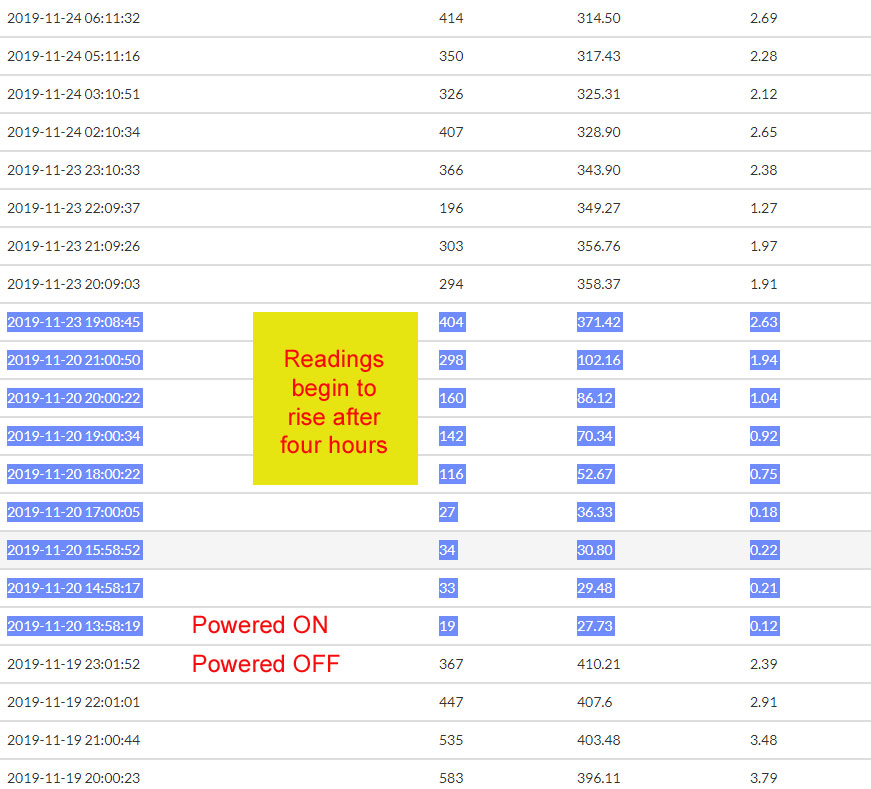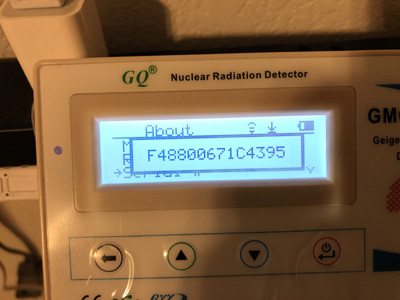| T O P I C R E V I E W |
| jtlockyer |
Posted - 12/22/2019 : 11:07:28
I need help with a GMC-320 Plus V5 where the readings will slowly creep-up to crazy-high levels beginning four hours after powering up.
My online readings logs are here:
www.gmcmap.com/historyData.asp?Param_ID=74008985570
Normally at a cold power up (unit has been off for 12-hours or more), the readings are in the normal range 20-40 CPM. After about four hours, the readings begin to rise and in a few more hours, the readings are easily in the 300-500 range. (A monitoring station two miles way typical shows levels under 30.) Powering off, waiting 12 hours, and re-starting returns reading to normal levels. See the attached image for an example.
I have tried:
- Placement in four locations in my home
- Used different power supplies or sources
- Removed battery and factory reset
All have not made a meaningful change in the problem.
Appreciate some ideas to fix the problem or guidance on a replacement from GQ
Image Insert:

124234 bytes |
| 6 L A T E S T R E P L I E S (Newest First) |
| Damien68 |
Posted - 01/09/2020 : 08:24:36
it can be a bad weld which makes contact only from time to time, or a poorly made weld that failed after a shock.
if it have trimmer to adjust HV, certainly it have a transformer and it's not the same HV generator design that newer GQ devices. so we can't stay on the normality or not of the measured 349v.
so, the best way is to use a 1G resistor to check HV output voltage.
I do not know the GQ policy but more and more manufacturers no longer do unity quality control at the end of production. it's true that the automated assembly processes are becoming very reliable (for some subcontractor, not for all ... ). |
| ullix |
Posted - 01/09/2020 : 01:11:02
I checked for your Fluke DVM, and it looks like it is of good quality. Importantly, it has an impedance of 10MOhm for Volt readings, which is typical for this kind of instrument. Although proper, this impedance is low for the needs to measure the high-voltage in a typical Geiger counter. It will make the voltage collapse.
Therefore it is very strange that you can measure such high voltages at a GM counter! I don't know what "C1" is, but 349V is unexpected.
The voltage across the tube of 291V is even stranger. To be sure: this voltage is measured between the anode and cathode of the tube, perhaps by making the contacts at the holder clips for the tube?
If so, it is wayyyyyyyy too high! One would expect something in the vicinity of 120V ... 150V. One cannot make more more precise statements, because the exact details of the DVM would have to be known, which is rarely ever the case.
Try this: Clamp the meter again to the clips to measure this voltage; it should again read something near the 291V. I don't have a 320 counter available, but near the plus end of the tube there should be a trim-potentiometer, labelled Rxy, xy being a number. Watch the voltmeter and turn the potentiometer with a screwdriver to LOWER the voltage to something near 150V. Careful to not make it higher!
Once you have the new voltage established, try the count measurement again.
It would be good to use a 1 GigaOhm resistor in series with voltmeter in order to be able to make a true voltage measurement. Can you get one?
Since this is a rather new instrument, and it is unlikely that you had played with its voltage settings, it is strange that the counter ever worked? And even stranger, that is must have had this setting since delivery. Which would be a sign of very poor quality control at manufacture.
|
| jtlockyer |
Posted - 01/08/2020 : 18:49:15
quote:
Originally posted by EmfDev
jtlockyer, yes please check the voltage if you are able to. If not you can email me your serial number then we can send you a firmware update.
The serial number is F48800671C4395. I am at revision 5.20
quote:
And please make sure that it is not from an external source.
I feel pretty good about external sources not influencing the behavior of the meter. I tried four locations around the house and different USB power sources. Day ot night, the readings are crazy high.
Thanks, John
Image Insert:

39429 bytes |
| jtlockyer |
Posted - 01/08/2020 : 18:35:24
quote:
Originally posted by ullix
How old is the counter? Has it been like this since day 1, or did it slowly or suddenly come up and if the latter how long had it been in operation?
The meter is less than a year old (purchased in Feb-2019) and the issue only appeared a few months ago.
quote:
Looks very much like an electronic problem or a defect tube problem. I see some faint hope for a voltage problem, being set too high (or too low?). Can you measure the voltage from anode to cathode?
I used a Fluke 87V to take some voltage measurements:
- USB Power is 5.07VDC at 50mA
- Voltage across the battery while on USB and 100% charged: 4.2VDC
- Voltage across battery while under load; 4.2VDC
- Voltage at C23: 4.7VDC
- Voltage at C26: 3.3VDC
- Voltage at C1: 349VDC
- Voltage at C2: 3.3VDC
- Voltage at Wi-Fi Module: 3.3VDC
- Voltage at terminal J2 G-to-V: 3.3VDC
The voltage across the tube shows 291VDC and I am not familiar with this type of electrical component, so I could be reading it incorrectly.
Thanks for the ideas!
|
| EmfDev |
Posted - 12/23/2019 : 11:25:46
jtlockyer, yes please check the voltage if you are able to. If not you can email me your serial number then we can send you a firmware update.
And please make sure that it is not from an external source. |
| ullix |
Posted - 12/23/2019 : 01:07:39
Strange.
How old is the counter? Has it been like this since day 1, or did it slowly or suddenly come up and if the latter how long had it been in operation?
Looks very much like an electronic problem or a defect tube problem. I see some faint hope for a voltage problem, being set too high (or too low?). Can you measure the voltage from anode to cathode? Be aware of the need for a high Ohm resistor, like 1 GigaOhm; see discussion here:
http://www.gqelectronicsllc.com/forum/topic.asp?TOPIC_ID=3745
You could measure without this resistor. I won't damage anything, but you will see something between 120 and 150V, and will be too uncertain unless you see very different results.
EDIT: just one thought: your data jump up at 1800h, just when at this time of the year you might have switched on the light in the house. And I know that some of these tubes/counters do show a weird response to light (and temperature). Please pack the counter in a light-tight enclosure to verify that it is not the light, and keep it in an environment with stable room-temperature!
|
|
|

